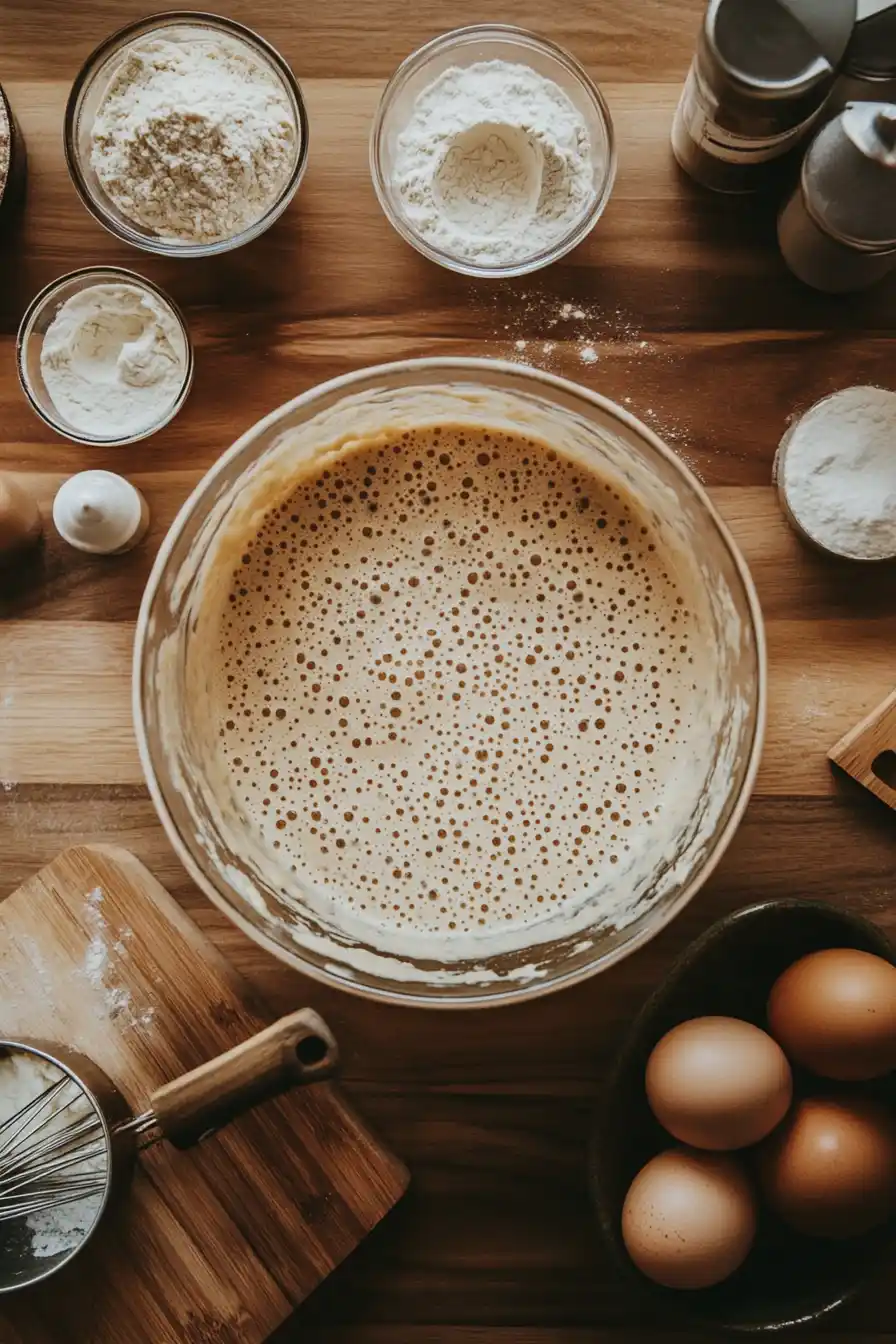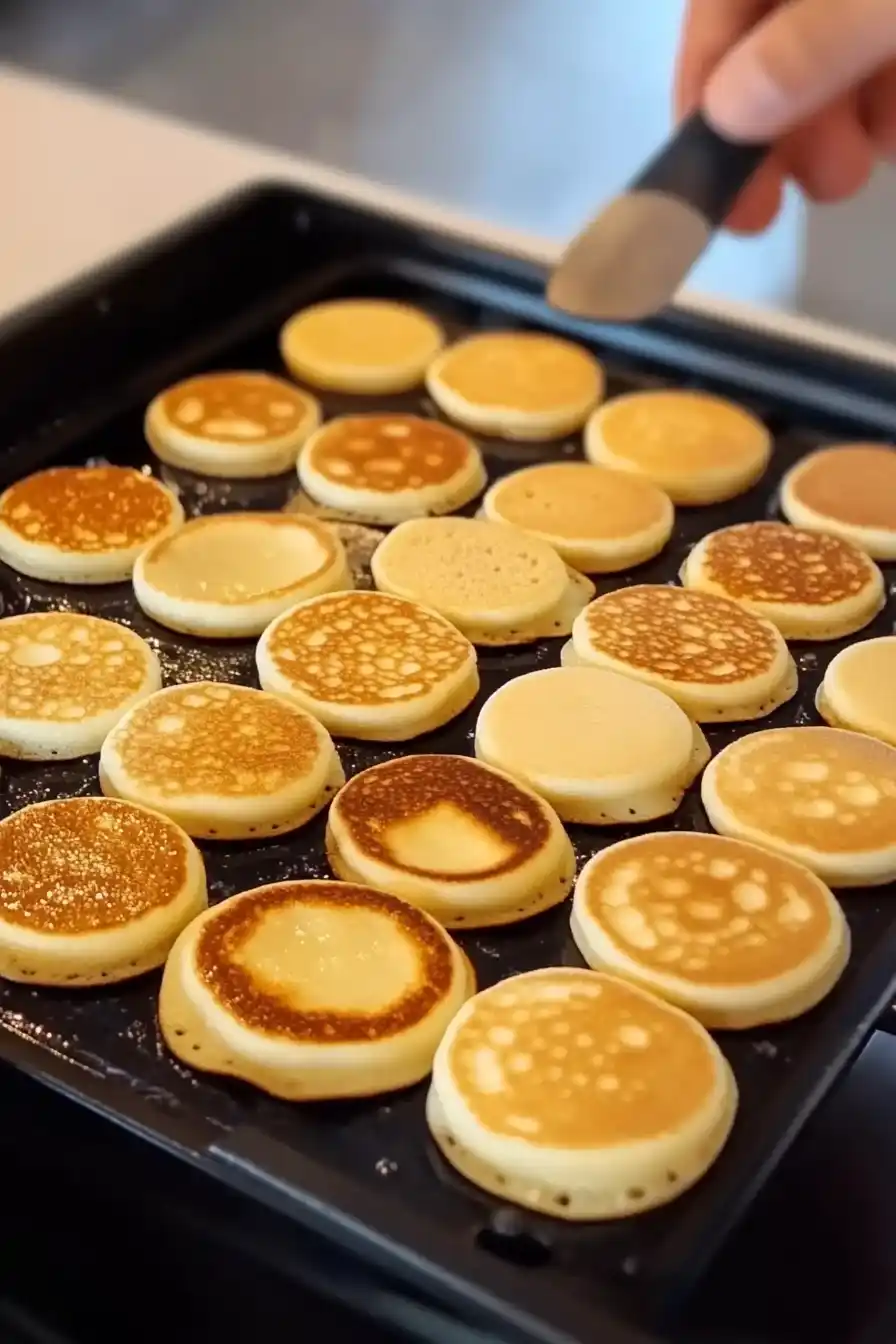Last updated on: March 17, 2025

Table of Contents
Why Mini Pancakes Are a Breakfast Favorite
Mini pancakes are more than just a fun-sized version of the classic breakfast dish—they’re a delightful, bite-sized treat that both kids and adults love. Whether you enjoy them stacked with syrup, topped with fruits, or dipped in chocolate, they are versatile and perfect for any occasion.
But have you ever made mini pancakes and ended up with flat, dry, or unevenly cooked results? If so, you might be making some common mistakes. Let’s dive into why mini pancakes are special and how to avoid these pitfalls so you can make them light, fluffy, and absolutely delicious.
The Secret to Light & Fluffy Mini Pancakes
What makes mini pancakes so irresistible? It’s all about the texture and flavor. The best mini pancakes are:
- Golden brown on the outside but soft and airy inside
- Slightly crisp at the edges with a delicate, melt-in-your-mouth texture
- Fluffy without being dense, holding their shape perfectly
So, how do you achieve this? The key lies in understanding the science of pancakes—from the batter consistency to the cooking process. Most people think that making mini pancakes is as simple as making regular pancakes, but their smaller size requires extra attention to detail.
“The difference between good and great pancakes is all in the technique. Even minor mistakes can change their texture completely.”
Common Issues People Face with Mini Pancakes
Even experienced home cooks struggle with mini pancakes from time to time. Here are some frustrating mistakes that can ruin your batch:
- Batter too thick or too runny – Leads to either heavy pancakes or ones that spread too thin
- Overcrowding the pan – Mini pancakes need space, or they’ll stick together and cook unevenly
- Cooking at the wrong temperature – If it’s too high, they burn outside but stay raw inside; too low, and they turn pale and tough
- Flipping too soon or too late – This affects their fluffiness and shape
- Skipping the batter resting time – This small step makes a huge difference in texture
Now that we know the common pitfalls, let’s break them down and learn how to fix them one by one.
Mistake #1 – Using the Wrong Batter Consistency

The most common issue with mini pancakes is incorrect batter consistency. Unlike regular pancakes, mini pancakes require a slightly thicker batter to hold their shape while cooking. If your batter is too thin, the pancakes will spread out too much, becoming flat and lifeless. If it’s too thick, they’ll be dense and heavy instead of light and airy.
Why Batter Thickness Matters for Mini Pancakes
Batter consistency directly affects texture. The right batter should:
- Flow smoothly but still hold a slight shape when poured
- Create small bubbles when resting, indicating good aeration
- Be lump-free (but not overmixed) to ensure an even cook
If your batter is too runny, the pancakes will be thin and crisp, lacking the desired fluffiness. If it’s too thick, they may remain undercooked inside while the exterior browns too fast.
“The key to the perfect pancake batter is balance. It should be thick enough to hold its shape, yet thin enough to spread slightly.”
How to Get the Perfect Mini Pancake Batter
To achieve ideal consistency, follow these expert tips:
- Use the right flour-to-liquid ratio – A standard recipe calls for about 1 cup of flour to ¾ cup of liquid.
- Don’t overmix the batter – Stir just until combined. Overmixing can lead to dense pancakes because it activates too much gluten.
- Let the batter rest – Allow it to sit for at least 10 minutes to hydrate the flour and create a lighter texture.
- Check the thickness – The batter should form ribbons when lifted with a spoon but not run like water.
Best Ingredients for Light and Fluffy Mini Pancakes
If you want fluffier, more flavorful mini pancakes, use the right ingredients. Here’s what works best:
| Ingredient | Quantity | Purpose |
|---|---|---|
| All-purpose flour | 1 cup | Provides structure |
| Baking powder | 1½ tsp | Helps pancakes rise |
| Sugar | 2 tbsp | Adds a touch of sweetness |
| Eggs | 1 large | Adds moisture and binds the batter |
| Milk | ¾ cup | Creates the right consistency |
| Butter (melted) | 2 tbsp | Adds richness and flavor |
| Vanilla extract | 1 tsp | Enhances taste |
Pro Tip: Want an extra boost of flavor? Try adding a pinch of cinnamon or a dash of nutmeg for a warm, cozy taste.
Mistake #2 – Overcrowding the Pan
Cooking mini pancakes might seem simple, but one of the biggest mistakes people make is putting too many pancakes in the pan at once. It’s tempting to cook more in one batch to save time, but this leads to uneven cooking and a frustrating experience.
Why Spacing Matters for Even Cooking
Unlike regular pancakes, mini pancakes need enough space to cook properly. When the pan is overcrowded:
- Heat distribution becomes uneven, causing some pancakes to cook faster than others.
- Pancakes stick together, making it difficult to flip them cleanly.
- There’s not enough airflow, preventing a golden-brown crust from forming.
“If you want perfectly cooked mini pancakes, think quality over quantity. Giving them space leads to an even, golden finish.”
To achieve perfect mini pancakes, leave at least half an inch of space between each one. This allows the heat to circulate and ensures they cook evenly on all sides.
How to Cook Mini Pancakes in Batches
Cooking in small batches might take a bit longer, but the results are worth it. Here’s how to do it efficiently:
- Preheat the pan – Heat your non-stick pan or griddle over medium-low heat.
- Use a squeeze bottle or spoon – Pour the batter into the pan, leaving enough space between pancakes.
- Cook in rounds – Instead of rushing, cook 6-8 pancakes at a time for better results.
- Keep cooked pancakes warm – Place finished pancakes on a plate covered with a clean towel or in a 200°F oven to stay warm.
By following this method, your mini pancakes will be fluffy, evenly cooked, and picture-perfect.
Best Pan and Heat Settings for Mini Pancakes
Choosing the right pan and setting the correct temperature are crucial for cooking mini pancakes evenly.
| Pan Type | Benefits |
|---|---|
| Non-stick skillet | Prevents sticking and requires less oil |
| Cast iron griddle | Holds heat well for an even cook |
| Electric griddle | Allows for precise temperature control |
For perfect results, set your heat to medium-low (around 325°F-350°F on an electric griddle). This ensures that pancakes cook through without burning.
Pro Tip: If the first batch cooks too fast or too slow, adjust the heat slightly. A steady, medium-low temperature is key to achieving fluffy, golden mini pancakes.
Mistake #3 – Cooking at the Wrong Temperature

Temperature plays a huge role in making perfect mini pancakes. If your pancakes are burning on the outside but raw inside, or if they turn out pale and chewy, you’re probably cooking at the wrong temperature.
How Heat Affects Mini Pancakes’ Texture
Cooking mini pancakes at too high or too low a temperature leads to different problems:
- High heat → Pancakes burn outside but stay undercooked inside.
- Low heat → Pancakes take too long to cook and become dense and rubbery.
The ideal cooking temperature allows mini pancakes to rise properly, develop a crispy edge, and cook evenly throughout.
“Mastering the right heat level is the secret to golden, fluffy mini pancakes every time.”
The Ideal Temperature for Cooking Mini Pancakes
To ensure perfectly cooked pancakes, follow this temperature guide:
| Heat Level | Effect on Pancakes |
|---|---|
| High (375°F+) | Burns outside, raw inside |
| Medium-High (350°F) | Cooks fast, may be uneven |
| Medium-Low (325°F-340°F) | Perfect golden brown, even cooking |
| Low (below 300°F) | Pale, takes too long, chewy |
The best method: Preheat your pan for 2-3 minutes, then cook over medium-low heat. This ensures your pancakes are fluffy, soft, and golden-brown.
How to Prevent Burning or Undercooking
If you’ve ever wondered why restaurant pancakes are so fluffy and perfectly cooked, it’s because they control temperature precisely. Here’s how to fix common temperature mistakes:
- If pancakes burn too fast → Lower the heat and let the pan cool slightly before continuing.
- If pancakes take too long to cook → Increase the heat slightly, but avoid going too high.
- Test with a small amount of batter → Cook a single test pancake to check the heat before making a full batch.
Pro Tip: To check if the pan is ready, sprinkle a few drops of water onto it. If they sizzle and evaporate within a few seconds, the pan is at the right temperature.
Mistake #4 – Flipping Too Early or Too Late
Flipping pancakes at the wrong time can ruin their texture, shape, and fluffiness. If you flip too early, the batter is still raw, causing the pancakes to collapse. If you flip too late, they become dry and tough.
The Right Time to Flip Mini Pancakes
The perfect flipping moment happens when you see:
✅ Bubbles forming on the surface
✅ Edges looking set and slightly dry
✅ Pancake easily lifting off the pan
If you flip too soon, your pancakes may stick and fall apart. If you flip too late, they become overcooked and chewy.
“Patience is key! Wait for the bubbles to pop before flipping to get fluffy mini pancakes.”
How to Tell If Mini Pancakes Are Ready to Flip
Use this step-by-step method to ensure perfect flips every time:
- Watch the bubbles – Tiny bubbles start appearing after 30-45 seconds.
- Check the edges – If they look dry and firm, it’s almost time to flip.
- Lift slightly with a spatula – If the pancake lifts easily without sticking, it’s ready to turn.
Common Flipping Mistakes and Fixes
| Mistake | How to Fix It |
|---|---|
| Flipping too early | Wait for more bubbles and set edges |
| Flipping too late | Lower heat to slow down cooking |
| Pancake sticks to pan | Use a non-stick pan and lightly grease it |
Flipping at the right time gives you soft, fluffy mini pancakes that hold their shape perfectly.
Mistake #5 – Not Letting the Batter Rest
One of the most overlooked steps when making mini pancakes is skipping the batter resting time. Many people mix their batter and immediately start cooking, but this simple mistake can lead to flat, dense, or tough pancakes instead of soft, fluffy bites.
Why Resting Batter Improves Mini Pancakes
Letting your pancake batter sit for at least 10 minutes before cooking allows the ingredients to fully combine and develop. Here’s why this step is crucial:
- Gluten relaxes → This makes the pancakes softer and more tender.
- Flour absorbs liquid → This creates a smoother consistency and prevents lumps.
- Leavening agents activate → Baking powder starts to work its magic, making the pancakes rise better.
“A well-rested batter creates fluffier, more consistent mini pancakes with a perfect golden-brown finish.”
Skipping this step can result in pancakes that don’t cook evenly, taste rubbery, or fail to rise properly.
How Long to Let Mini Pancake Batter Rest
The ideal resting time depends on the type of ingredients used:
| Resting Time | Best for |
|---|---|
| 10-15 minutes | Standard pancake batter |
| 30 minutes | Whole wheat or oat-based batter |
| Up to 1 hour | For extra fluffy texture |
A short rest (10 minutes) is enough for a basic batter, but longer resting times help develop a richer flavor and airier texture.
Quick Tricks to Speed Up Batter Resting
If you’re short on time but still want fluffy mini pancakes, try these shortcuts:
- Use warm (not hot) milk – This helps the flour hydrate faster.
- Whisk the batter well, then cover it – This speeds up the absorption process.
- Refrigerate for a few minutes – A 5-minute chill can help develop better consistency.
“Patience is the secret ingredient for great pancakes. Even a short rest makes a big difference in texture.”
Now that we’ve covered all the major mistakes, let’s move on to answering some frequently asked questions about mini pancakes.
FAQs About Mini Pancakes
Mini pancakes are a popular treat, but many people still have questions about them. Below are some of the most commonly asked questions and their answers.
What Is Another Name for Mini Pancakes?
Mini pancakes go by different names around the world. Some common variations include:
- Silver dollar pancakes (USA) – Because they’re roughly the size of an old silver dollar.
- Poffertjes (Netherlands) – A Dutch version that is slightly puffier and often dusted with powdered sugar.
- Pikelets (Australia & UK) – A thinner variation, sometimes served with jam and cream.
- Blini (Russia) – Often served with savory toppings like sour cream or caviar.
Each version has its own unique texture and flavor, but they all share the same bite-sized charm.
Why Are Mini Pancakes the Perfect Breakfast Treat?
Mini pancakes are a breakfast favorite because they are:
✅ Fun to eat – Their small size makes them perfect for kids and adults alike.
✅ Quick to cook – They take just a few minutes per batch.
✅ Customizable – You can top them with anything—fruits, chocolate, syrup, or yogurt.
✅ Easy to make ahead – They store well and can be reheated for busy mornings.
Whether you prefer them sweet, savory, or healthy, mini pancakes offer a versatile and delicious option for breakfast or snacks.
How Long Do You Cook Mini Pancakes For?
The cooking time depends on pan temperature and batter consistency, but in general:
| Cooking Time | Step |
|---|---|
| 1-2 minutes | Cook the first side until bubbles form and the edges look set. |
| 30-45 seconds | Flip and cook the other side until golden brown. |
To avoid overcooking, check for these signs:
- The edges look dry before flipping.
- The bottom is golden-brown and lifts easily with a spatula.
- The center springs back when lightly pressed.
“Cooking mini pancakes is all about timing—watch for bubbles and golden edges for the perfect flip.”
Why Are Restaurant Pancakes So Fluffy?
Ever wonder why restaurant pancakes turn out fluffier than homemade ones? Here’s their secret:
- They use buttermilk – This adds acidity that activates baking powder, making pancakes extra light.
- They rest the batter – Some restaurants let the batter sit for hours before cooking.
- They control temperature – Cooking on a steady medium-low heat ensures even rising.
- They use whipped egg whites – Some chefs separate eggs and fold in beaten egg whites for a cloud-like texture.
For homemade mini pancakes that rival restaurant quality, try using buttermilk or whipping your egg whites separately before folding them in.
Want to know the full secret to restaurant-style fluffiness? Here’s why restaurant pancakes turn out so perfect.
Final Thoughts on Perfecting Mini Pancakes
Now that you know the five most common mistakes and how to avoid them, you’re ready to make perfect mini pancakes every time. Let’s recap the key takeaways:
Key Takeaways to Avoid These Mistakes
- ✅ Use the right batter consistency – Not too thick, not too thin.
- ✅ Don’t overcrowd the pan – Give each pancake space to cook evenly.
- ✅ Control your heat – Medium-low (325°F-340°F) is the sweet spot.
- ✅ Flip at the right time – Wait for bubbles and set edges.
- ✅ Let the batter rest – At least 10 minutes for fluffier results.
By following these tips, you’ll get golden, fluffy, and delicious mini pancakes every time.
Pro Tips for the Best Mini Pancakes Every Time
Want to take your pancakes to the next level? Try these expert hacks:
✔ Use creamy parmesan Italian sausage soup as a savory topping for a rich, unique flavor.
✔ Experiment with different flours like oat or almond for a healthier version.
✔ Try flavored syrups like honey cinnamon or maple vanilla for a twist.
✔ Make mini pancake cereal by cooking tiny pancakes and serving them in a bowl with milk!
For a full guide on making and serving mini pancakes, check out our Mini Pancake Breakfast Guide.

